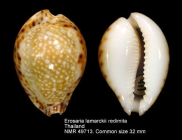WoRMS name details
Erosaria lamarckii redimita (Melvill, 1888)
572241 (urn:lsid:marinespecies.org:taxname:572241)
unaccepted
Subspecies
marine, brackish, fresh, terrestrial
recent only
(of Cypraea lamarckii J. E. Gray, 1825) Gray, J.E. (1824-1828). Monograph on the Cypraeidae, a family of testaceous Mollusca. <em>Zoological Journal.</em> 1(1): 71-80, pl. 7 [March 1824]; 1(2): 137-152 [June 1824]; 1(3): 367-391, pl. 12 [October 1824]; 1(4): 489-518, 603 (unnumbered Errata and Addendum) [January 1825]; 3(11): 363-371 [December 1827]; 3(12): 567-576 [April 1828]; 4(14): 66-88 (additions and corrections) [July 1828]., available online at https://www.biodiversitylibrary.org/page/27570798
page(s): 506-507 [details]
page(s): 506-507 [details]
MolluscaBase eds. (2024). MolluscaBase. Erosaria lamarckii redimita (Melvill, 1888). Accessed through: World Register of Marine Species at: https://www.marinespecies.org/aphia.php?p=taxdetails&id=572241 on 2024-04-23
Date
action
by
![]() The webpage text is licensed under a Creative Commons Attribution 4.0 License
The webpage text is licensed under a Creative Commons Attribution 4.0 License
original description
(of Cypraea lamarckii J. E. Gray, 1825) Gray, J.E. (1824-1828). Monograph on the Cypraeidae, a family of testaceous Mollusca. <em>Zoological Journal.</em> 1(1): 71-80, pl. 7 [March 1824]; 1(2): 137-152 [June 1824]; 1(3): 367-391, pl. 12 [October 1824]; 1(4): 489-518, 603 (unnumbered Errata and Addendum) [January 1825]; 3(11): 363-371 [December 1827]; 3(12): 567-576 [April 1828]; 4(14): 66-88 (additions and corrections) [July 1828]., available online at https://www.biodiversitylibrary.org/page/27570798
page(s): 506-507 [details]
source of synonymy Lorenz, F. (2017). Cowries. A guide to the gastropod family Cypraeidae. <em>Volume 1, Biology and systematics. Harxheim: ConchBooks.</em> 644 pp. [details]
page(s): 506-507 [details]
source of synonymy Lorenz, F. (2017). Cowries. A guide to the gastropod family Cypraeidae. <em>Volume 1, Biology and systematics. Harxheim: ConchBooks.</em> 644 pp. [details]
 Present
Present  Present in aphia/obis/gbif/idigbio
Present in aphia/obis/gbif/idigbio  Inaccurate
Inaccurate  Introduced: alien
Introduced: alien  Containing type locality
Containing type locality
From editor or global species database
Validity DNA tested by Chris Meyer (CGDP) and not recognized as an Evolutionarily Significant Unit (ESU). Until more evidence becomes available to validate it, it should be considered a species inquirenda. [details]
